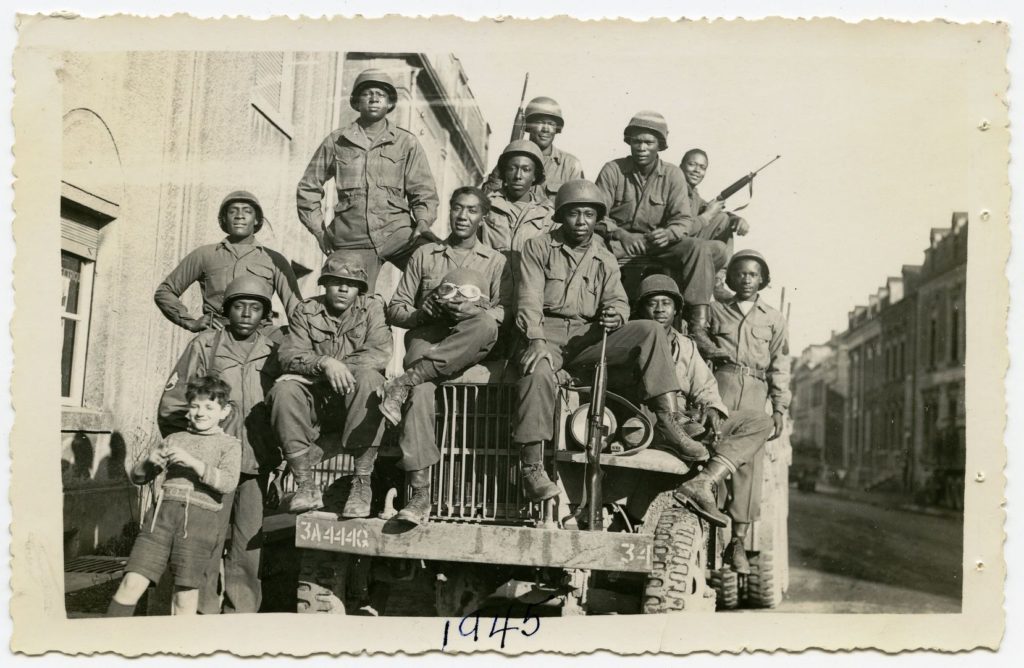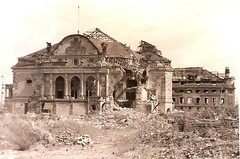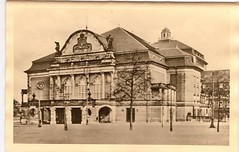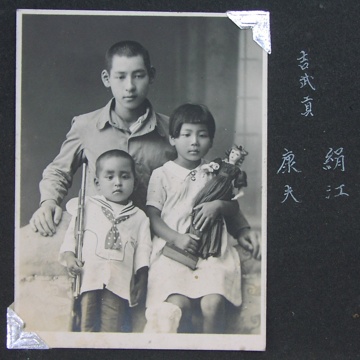
There is something I love about this picture. Something about pride and camaraderie and self-awareness, maybe, in what must have been a hell of a difficult situation. And then there’s the kid posing with this group of GIs.
But before I get into that, where did this picture come from? Someone posted it on Facebook, in the Oakland history group, as a Memorial Day tribute, I think. The picture was captioned there “A 1945 picture of Soldiers in Oakland, CA.” As commenters quickly pointed out, the background in the shot suggests someplace in Europe — France, or Italy maybe — but not Oakland. And then there’s the kid posing with the group. Maybe these troops were among those who had just liberated his town from the Germans.
Is there some way of nailing down who and where these men are? I’d love to see whether anything is written on the back of the photo. It’s a holiday, though, and I have no idea whether the library that holds this photograph has been open at all during our lockdown the last couple of months. Maybe I’ll find that out tomorrow.
There is one potentially helpful detail in the picture: The numbers on the right side (left side in the picture) of the truck’s bumper: 3A-444Q.
My guess was that “3A” stands for “3rd Army,” the force that Gen. George Patton commanded and which is renowned for, among other things, its rapid push across France in the summer and early fall of 1944, after D-Day. Then maybe the 444Q stood for — what? A regimental unit?
I found a post — because you can find a post about just about anything when you go looking — that helped sort out the truck number. It includes a picture of vehicles attached to the Japanese American 442nd Regimental Combat Team, originally part of the 3rd Army. The markings on those vehicles read “3A-442-I.” From there, I just looked for names of units numbered “444.” I came across a mention of a 444th Quartermaster Truck Company, described as a segregated, all-black unit.
Where were they deployed during the war? It appears they were attached to the 3rd Army’s 4th Armored Division in France and Germany in 1944 and ’45. They’re cited as having played a role in several major actions: Arracourt, the Battle of the Bulge and the final Allied offensive into Germany in March and April 1945. They were likely part of the legendary “Red Ball Express,” responsible for supplying the 3rd Army during its race toward Germany.
The Bulge Bugle, the official publication of the Veterans of the Battle of the Bulge Inc., mentioned the 444th in its May 2005 edition:
“… Many an unsung deed of heroism, endurance and devotion to duty were quietly chalked up by the Third’s QM truckers. They rolled on unceasingly through German strafing, bullets, artillery fire, ice and snow, fatigue, hunger, blackouts and every other imaginable obstacle.
Trucks of the 444th QM Truck Company moved the 4th Armored Division from the Saar to Belgium in 17 hours. In their usual fashion the 4th Armored Division fought their way through to relieve the heroic bastion of Bastogne and the tide began to turn in our favor. …”
I can’t find a lot more on the 444th. A couple of records concern company members who died during their service and are buried in cemeteries in France and England. One document concerns a soldier who was convicted of murdering a German civilian during the last month of the war. Somewhere out there, there’s an Army publication called “How the 444 Rolled,” but I can’t find any evidence of it online or in libraries.
Looking at that picture, though, makes me want to know about the men there: what they had come through to get to that street, wherever it was; what they went on to; what was waiting for them in the United States when they got back from a brutal tour of duty. On the off chance anyone who knows more about the 444th comes across this, I’d love to hear from you. In the meantime, I’m going to see if I can track down the original of the picture to see if there’s anything on the back.



